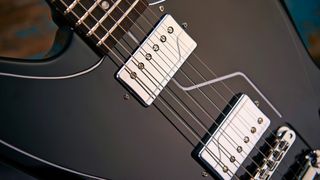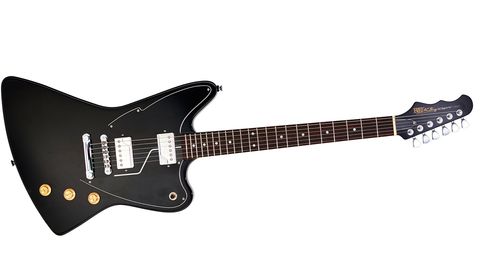New technology rarely comes cheap and when Fishman entered the electric guitar pickup market with its Fluence pickups, as retrofits, they certainly seemed on the steep side in terms of price.
For example, a set of Fluence single coil-sized ‘single width’ units will cost you £319; a pair of standard humbucking sized pickups start at £359 (neither includes a rechargeable battery pack). If you want to install the Greg Koch signature Gristle- Tone set for a Tele-style guitar, the whole package, including rechargeable battery pack, will cost you £589.
John Hornby Skewes (JHS) distributes Fishman products in the UK and is also behind the Trev Wilkinson-designed Fret-King brand. Thanks to its ‘special relationship’, it has somehow managed to utilise this Fluence technology and very thoughtfully include a pretty sharp guitar for sub-£750. Game on!
This new guitar in the new Fluence-equipped range typifies what we, and many other players, have been saying for ages: Fret-King makes very good guitars. Indeed, if there were a definition of its Black Label instruments, it might read “nicely made working tools for working musicians”. It ain’t the hippest brand on the block, but its ‘affordable boutique’ marketing tag is accurate, as we see here.

The none-more-black Esprit uses agathis for its original Jazzmaster-meets-Explorer body and a maple set-neck, with a 22-fret ’board, while its dual humbuckers and ubiquitous tune-o-matic/stud tailpiece combo and shorter scale of 635mm (25 inches) fill the Gibson-esque slot.
The Esprit has two Fluence Classic Humbuckers. We also see active ‘multi voices’ via a pull-push switch on the lower tone controls. The Classic Humbuckers each have their own dedicated preamp, so potentially you can have Voice 1 on the bridge, for example, and Voice 2 on the neck. There’s only one switch wired here, however, so that’s not possible. Still, the voices of each humbucker are slightly different: the neck humbucker offers ‘Vintage Humbucker’ (Voice 1) or ‘Clear, Airy Chime’ (Voice 2), while the bridge goes for ‘Vintage PAF’ (Voice 1) and the over- wound-style ‘Classic Hotrod’ (Voice 2).
Sounds
The trouble is, with such icons of the electric guitar, we all have our perceptions of how they should sound: we plug in and after a couple of strums think, ‘It’s not the same as my ’52, ’54...’ or whatever. Well, we’re listening to Fret-King here and with these Fluence pickups we’re getting plenty to listen to. First, there’s virtually no hum pick-up. Second, there are the different voices: they’re not like chalk and cheese, but relatively subtle shades of the same.
From a critical standpoint, the Esprit It really doesn’t disappoint... and that’s just the neck with it’s fabulous clubby C profile that’s only a shade thinner than this writer’s old ’57 Junior.
There’s a smooth attack to the note but plenty of sparkle, and starting clean it summons up James Honeyman-Scott’s work with The Pretenders - jangle and bite. Into a little Vox AC10, we may have found a near-perfect small volume recording setup, although with the subtly shorter 635mm scale length (as opposed to 648mm) and its surprisingly resonant, lightweight construction, we’d definitely go for bigger strings.
There’s a slightly spiky, more P-90 edge here, too, on each’s Voice 1 settings. The bridge’s Voice 2 gives a little extra kick, and the neck’s second voice offers us a wonderfully soupy but clear voice that’s ideal for lightly gained, boosted lead tones. Comparing this with a Yamaha SG1820 equipped with the same pickups illustrates the point: the Esprit has the rawer edge to the thicker, more Les Paul-like sound of the SG. Same microphones, different voices.
Credit where it’s due, these are simply very good guitars. With the huge experience and production nous of Trev Wilkinson, Fishman’s Fluence technology and what seem to be extremely competitive prices, we’re struggling to think of a player who couldn’t use these. And if you’re handy with a soldering iron, you can tweak the wiring for considerably more ‘voices’.


